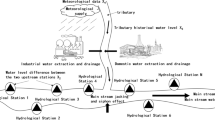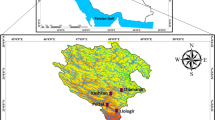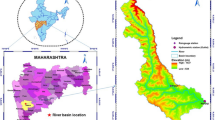Abstract
Accurate and reliable long-term forecasting plays an important role in water resources management and utilization. In this paper, a hybrid model called SVR-HUP is presented to predict long-term runoff and quantify the prediction uncertainty. The model is created based on three steps. First, appropriate predictors are selected according to the correlations between meteorological factors and runoff. Second, a support vector regression (SVR) model is structured and optimized based on the LibSVM toolbox and a genetic algorithm. Finally, using forecasted and observed runoff, a hydrologic uncertainty processor (HUP) based on a Bayesian framework is used to estimate the posterior probability distribution of the simulated values, and the associated uncertainty of prediction was quantitatively analyzed. Six precision evaluation indexes, including the correlation coefficient (CC), relative root mean square error (RRMSE), relative error (RE), mean absolute percentage error (MAPE), Nash-Sutcliffe efficiency (NSE), and qualification rate (QR), are used to measure the prediction accuracy. As a case study, the proposed approach is applied in the Han River basin, South Central China. Three types of SVR models are established to forecast the monthly, flood season and annual runoff volumes. The results indicate that SVR yields satisfactory accuracy and reliability at all three scales. In addition, the results suggest that the HUP cannot only quantify the uncertainty of prediction based on a confidence interval but also provide a more accurate single value prediction than the initial SVR forecasting result. Thus, the SVR-HUP model provides an alternative method for long-term runoff forecasting.








Similar content being viewed by others
References
Adamowski J, Sun K (2010) Development of a coupled wavelet transform and neural network method for flow forecasting of non-perennial rivers in semi-arid watersheds. J Hydrol 390(1–2):85–91
Adamowski J, Chan HF, Prasher SO, Ozga-Zielinski B, Sliusarieva A (2012) Comparison of multiple linear and nonlinear regression, autoregressive integrated moving average, artificial neural network, and wavelet artificial neural network methods for urban water demand forecasting in Montreal, Canada. Water Resour Res 48:14
Ahmadi A, Han DW (2013) Identification of dominant sources of sea level pressure for precipitation forecasting over Wales. J Hydroinf 15(3):1002–1021
Ajami NK, Duan Q, Sorooshian S (2007) An integrated hydrologic Bayesian multimodel combination framework: confronting input, parameter, and model structural uncertainty in hydrologic prediction. Water Resour Res 43(1):208–214
Alexander MA, Kilbourne KH, Nye JA (2014) Climate variability during warm and cold phases of the Atlantic Multidecadal Oscillation (AMO) 1871–2008. J mar Syst 133(3):14–26
Allan R, Ansell T (2006) A new globally complete monthly historical gridded mean sea level pressure dataset (HadSLP2): 1850 2004. J Clim 19(22):5816
Aqil M, Kita I, Yano A, Nishiyama S (2007) A comparative study of artificial neural networks and neuro-fuzzy in continuous modeling of the daily and hourly behaviour of runoff. J Hydrol 337(1–2):22–34
Box GEP, Jenkins GM (2010) Time series analysis: forecasting and control. J Time Ser Anal 22(4):199–201
Chattopadhyay M, Chattopadhyay S (2016) Elucidating the role of topological pattern discovery and support vector machine in generating predictive models for Indian summer monsoon rainfall. Theor Appl Climatol 126(1–2):93–104
Chavasse DI, Seoane RS (2009) Assessing and predicting the impact of El Niño Southern Oscillation (ENSO) events on runoff from the Chopim River basin, Brazil. Hydrol Process 23(22):3261–3266
Cherkassky, V., (2000) The nature of statistical learning theory~, Springer
Cloke HL, Pappenberger F (2009) Ensemble flood forecasting: a review. J Hydrol 375(3–4):613–626
D’Arrigo R, Ummenhofer CC (2015) The climate of Myanmar: evidence for effects of the Pacific Decadal Oscillation. Int J Climatol 35(4):634–640
Gao JB, Gunn SR, Harris CJ, Brown M (2002) A probabilistic framework for SVM regression and error bar estimation. Mach Learn 46(1):71–89
Gudmundsson L, Seneviratne SI (2015) Towards observation-based gridded runoff estimates for Europe. Hydrol Earth Syst Sci 19(6):2859–2879
Guo J, Zhou JZ, Qin H, Zou Q, Li QQ (2011) Monthly streamflow forecasting based on improved support vector machine model. Expert Syst Appl 38(10):13073–13081
Harshburger B, Ye H, Dzialoski J (2002) Observational evidence of the influence of Pacific SSTs on winter precipitation and spring stream discharge in Idaho. J Hydrol 264(1–4):157–169
He Z, Wen X, Liu H, Du J (2014) A comparative study of artificial neural network, adaptive neuro fuzzy inference system and support vector machine for forecasting river flow in the semiarid mountain region. J Hydrol 509(529):379–386
Huang YY, Xiao-Fan LI (2015) The interdecadal variation of the western Pacific subtropical high as measured by 500 hPa eddy geopotential height. Atmos Ocean Sci Lett 8(6):371–375
Huang S, Chang J, Huang Q, Chen Y (2014) Monthly streamflow prediction using modified EMD-based support vector machine. J Hydrol 511(7):764–775
Jiang P, Gautam MR, Zhu J, Yu Z (2013) How well do the GCMs/RCMs capture the multi-scale temporal variability of precipitation in the Southwestern United States? J Hydrol 479(479):75–85
Karamouz M, Ahmadi A, Moridi A (2009) Probabilistic reservoir operation using Bayesian stochastic model and support vector machine. Adv Water Resour 32(11):1588–1600
Karpouzos DK, Delay F, Katsifarakis KL, Marsily GD (2001) A multipopulation genetic algorithm to solve the inverse problem in hydrogeology. Water Resour Res 37(9):2291–2302
Kavetski, D., Kuczera, G. and Franks, S. (2006a) Bayesian analysis of input uncertainty in hydrological modeling: 1. Theory
Kavetski D, Kuczera G, Franks SW (2006b) Bayesian analysis of input uncertainty in hydrological modeling: 1. Theory Water Resour Res 42(3):446–455
Kelly KS, Krzysztofowicz R (2000) Precipitation uncertainty processor for probabilistic river stage forecasting. Water Resour Res 36(11):3265–3278
Kobold M, Suselj K (2005) Precipitation forecasts and their uncertainty as input into hydrological models. Hydrol Earth Syst Sci 9(4):322–332
Krause P, Boyle DP, Se FB (2005) Comparison of different efficiency criteria for hydrological model assessment. Adv Geosci 5(5):89–97
Krzysztofowicz R (1999) Bayesian theory of probabilistic forecasting via deterministic hydrologic model. Water Resour Res 35(9):2739–2750
Krzysztofowicz R (2002) Bayesian system for probabilistic river stage forecasting. J Hydrol 268(1–4):16–40
Legates DR, Mccabe GJ (1999) Evaluating the use of “goodness-of-fit” measures in hydrologic and hydroclimatic model validation. Water Resour Res 35(1):233–241
Li B, Yu Z, Liang Z, Song K, Li H, Wang Y, Zhang W, Acharya K (2014) Effects of climate variations and human activities on runoff in the Zoige Alpine Wetland in the eastern edge of the Tibetan Plateau. J Hydrol Eng 19(5):1026–1035
Liang ZM, Dai R, Li BQ (2010) A review of hydrological uncertainty analysis based on Bayesian theory. Shuikexue Jinzhan/Adv Water Sci 21(2):274–281
Lin GF, Chen GR, Huang PY, Yangching C (2009) Support vector machine-based models for hourly reservoir inflow forecasting during typhoon-warning periods. J Hydrol 372(1–4):17–29
Lin GF, Chou YC, Wu MC (2013) Typhoon flood forecasting using integrated two-stage support vector machine approach. J Hydrol 486:334–342
Ma Z, Li Z, Zhang M, Fan Z (2013) Bayesian statistic forecasting model for middle-term and long-term runoff of a hydropower station. J Hydrol Eng 18(11):1458–1463
Mahmoodi NM, Arabloo M, Abdi J (2014) Laccase immobilized manganese ferrite nanoparticle: synthesis and LSSVM intelligent modeling of decolorization. Water Res 67(1):216–226
Nash JE, Sutcliffe JV (1970) River flow forecasting through conceptual models part I—a discussion of principles ☆. J Hydrol 10(3):282–290
Noori R, Karbassi AR, Moghaddamnia A, Han D, Zokaei-Ashtiani MH, Farokhnia A, Gousheh MG (2011) Assessment of input variables determination on the SVM model performance using PCA, gamma test, and forward selection techniques for monthly stream flow prediction. J Hydrol 401(3–4):177–189
Nourani V, Alizadeh F, Roushangar K (2016) Evaluation of a two-stage SVM and spatial statistics methods for modeling monthly river suspended sediment load. Water Resour Manag 30(1):393–407
Pettitt AN (1979) A non-parametric approach to the change-point problem. J R Stat Soc 28(2):126
Rajurkar MP, Kothyari UC, Chaube UC (2004) Modeling of the daily rainfall-runoff relationship with artificial neural network. J Hydrol 285(1–4):96–113
Reggiani P, Weerts AH (2008) A Bayesian approach to decision-making under uncertainty: an application to real-time forecasting in the river Rhine. J Hydrol 356(1–2):56–69
Renard B, Garreta V, Lang M (2006) An application of Bayesian analysis and Markov chain Monte Carlo methods to the estimation of a regional trend in annual maxima. Water Resour Res 42(12):4407–4413
Risko SL, Martinez CJ (2014) Forecasts of seasonal streamflow in West-Central Florida using multiple climate predictors. J Hydrol 519:1130–1140
Sahay RR, Srivastava A (2014) Predicting monsoon floods in rivers embedding wavelet transform, genetic algorithm and neural network. Water Resour Manag 28(2):301–317
Shabri A, Suhartono (2012) Streamflow forecasting using least-squares support vector machines. Hydrol Sci J—J Des Sci Hydrol 57(7):1275–1293
Shenton W, Hart BT, Chan TU (2014) A Bayesian network approach to support environmental flow restoration decisions in the Yarra River, Australia. Stoch Env Res Risk A 28(1):57–65
Sivakumar B, Berndtsson R, Olsson J, Jinno K (1999) Dynamics of monthly rainfall-runoff process at the Gota basin: a search for chaos. Hydrol Earth Syst Sci 4(3):407–417
Tetzlaff DD, Brewer MJ, Malcolm IA, Soulsby C (2010) Storm flow and baseflow response to reduced acid deposition—using Bayesian compositional analysis in hydrograph separation with changing end members. Hydrol Process 24(16):2300–2312
Tripathi S, Srinivas VV, Nanjundiah RS (2006) Downscaling of precipitation for climate change scenarios: a support vector machine approach. J Hydrol 330(3–4):621–640
Vapnik VN (1995) The nature of statistical learning theory. IEEE Trans Neural Netw 8(6):988–999
Vapnik, V.N. (2000) The Nature of Statistical Learning Theory, Springer
Wang E, Zhang Y, Luo J, Chiew FHS, Wang QJ (2011) Monthly and seasonal streamflow forecasts using rainfall-runoff modeling and historical weather data. Water Resour Res 47(5):1296–1300
Wang WC, Xu DM, Chau KW, Chen S (2013) Improved annual rainfall-runoff forecasting using PSO-SVM model based on EEMD. J Hydroinf 15(4):1377–1390
Wang WC, Chau KW, Qiu L, Chen YB (2015a) Improving forecasting accuracy of medium and long-term runoff using artificial neural network based on EEMD decomposition. Environ Res 139:46–54
Wood EF, Rodríguez-Iturbe I (1975) Bayesian inference and decision making for extreme hydrologic events. Water Resour Res 11(4):533–542
Wu CL, Chau KW, Li YS (2009) Predicting monthly streamflow using data-driven models coupled with data-preprocessing techniques. Water Resour Res 45(8):2263–2289
Xiong L, Shamseldin AY, O’Connor KM (2001) A non-linear combination of the forecasts of rainfall-runoff models by the first-order Takagi–Sugeno fuzzy system. J Hydrol 245(1–4):196–217
Xu G, Lu K, Li Z, Li P, Wang T, Yang Y (2015) Impact of soil and water conservation on soil organic carbon content in a catchment of the middle Han River, China. Environ Earth Sci 74(8):6503–6510
Yang L, Tian F, Sun Y, Yuan X, Hu H (2013) Attribution of hydrologic forecast uncertainty within scalable forecast windows. Hydrol Earth Syst Sci Discuss 10(9):11795–11828
Yuan, F., Berndtsson, R., Uvo, C.B., Zhang, L. and Jiang, P. (2015) Summer precipitation prediction in the source region of the Yellow River using climate indices. Hydrol Res
Yuan F, Yasuda H, Berndtsson R, Uvo CB, Zhang L, Hao Z, Wang X (2016) Regional sea-surface temperatures explain spatial and temporal variation of summer precipitation in the source region of the Yellow River. Hydrol Sci J/J Des Sci Hydrol 61(8):150402033343007
Zhang X, Peng Y, Zhang C, Wang B (2015) Are hybrid models integrated with data preprocessing techniques suitable for monthly streamflow forecasting? Some experiment evidences. J Hydrol 530:137–152
Acknowledgements
This study was supported by the National Key Research and Development Program of China (Grant Nos. 2016YFC0402706, 2016YFC0402707, and 2016YFC0402709). We gratefully acknowledge the anonymous editors and reviewers for their insightful and professional comments, which greatly improved this manuscript.
Author information
Authors and Affiliations
Corresponding author
Rights and permissions
About this article
Cite this article
Liang, Z., Li, Y., Hu, Y. et al. A data-driven SVR model for long-term runoff prediction and uncertainty analysis based on the Bayesian framework. Theor Appl Climatol 133, 137–149 (2018). https://doi.org/10.1007/s00704-017-2186-6
Received:
Accepted:
Published:
Issue Date:
DOI: https://doi.org/10.1007/s00704-017-2186-6




